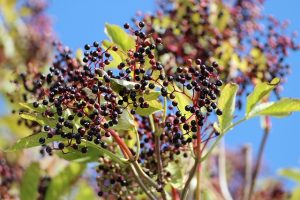(Sambucas nigra)
Elder is an abundant part of many wild hedgerows and it is easy to recognise. The flowers and the berries are edible, and can be used in a variety of culinary dishes, preserves and beverages. The bark, leaves and roots of an Elder should not be eaten.
 What does Elder look like?
What does Elder look like?
Umbrella shaped clusters of small white, fragrant flowers appear in spring. They are followed by jewel-like single berries that are green at first, then ripen to a shiny black colour. Elder has long stems from which the leaves grow, and they are round at the bottom, pointed at the tip and serrated.
How to eat Elder
Raw Elderberries do contain some toxins, so it is important to cook them before eating. Raw berries can make some people feel nauseous.
Elderberries are good for jam making. They can also be used as an interesting fruit to bake in cakes, or add to fruit pies and crumbles.
Elderflowers make refreshing cold cordials and wines. The flowers can also be sprinkled onto salads, or are delicious when cooked as a fritter.
Health benefits of Elder
Elder is thought to have lots of healing attributes. The flowers can be infused and used as a mouthwash to treat sore throats, mouth ulcers and other problems. Elderflower tea is thought to help to lessen inflammation from arthritis, rheumatism and gout. Elder provides a boost to the immune system and is a good detoxifier.
Back to list of wild edible foods




